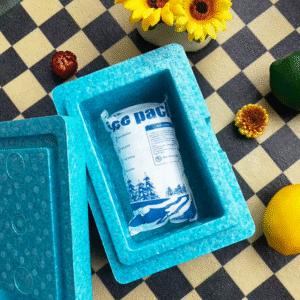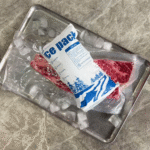How to Use Dry Ice in Coolers for Safe and Efficient Shipping
Shipping temperature-sensitive items, such as perishable food, Impfungen, and biotech samples, erfordert zuverlässige Kühllösungen. Using coolers with dry ice packs is an effective way to keep items frozen for extended periods without the mess of melting ice. In diesem Leitfaden, we will cover the steps on how to use dry ice in coolers sicher, Best Practices, and the benefits it offers in modern cold chain logistics.
Whether you are shipping seafood, Arzneimittel, oder andere verderbliche Waren, dry ice is one of the most efficient ways to maintain low temperatures. At -78.5°C (-109.3° F), dry ice is significantly colder than regular ice, making it ideal for shipments that require extended freezing. This guide will walk you through the process of using dry ice in coolers for safe and efficient shipping.
-
How dry ice works in coolers
-
Best practices for safe dry ice handling
-
How to pack coolers efficiently with dry ice
-
Comparing dry ice and regular ice for different shipping needs
-
Key regulations and compliance for shipping with dry ice
How Does Dry Ice Work in Coolers?
Trockeneis ist festes Kohlendioxid (Co₂) and sublimates directly into gas at a temperature of -78.5°C (-109.3° F). Im Gegensatz zu normalem Eis, was zum Wasser schmilzt, dry ice does not leave any residue, making it ideal for long-duration shipments. The cooling effect occurs as dry ice absorbs heat from the surrounding environment, keeping items inside the cooler frozen for much longer than regular ice.
Key Benefits of Using Dry Ice in Coolers
-
Verlängerte Kühldauer: Dry ice keeps contents frozen for longer periods compared to regular ice, which is crucial for long-distance shipments.
-
Keine Wasserrückstände: Seit Trockeneis unterming in Gas, there’s no risk of water damage to your goods, which is especially important for sensitive items.
-
Efficient Space Utilization: Dry ice takes up less space than regular ice, allowing you to pack more items without sacrificing cooling efficiency.
-
Better for Sensitive Items: Dry ice is preferred for shipping pharmaceuticals, Impfungen, and biotech samples, as it maintains a constant low temperature.
Wie man einen Kühler mit Trockeneis packt: Eine Schritt-für-Schritt-Anleitung
Schritt 1: Select the Right Cooler
Choose a cooler that is well-insulated and can accommodate both your items and the dry ice. A high-quality cooler helps retain cold for longer and is essential for ensuring the dry ice lasts for the necessary duration.
-
Isolationsqualität: Select coolers that feature thick insulation to prevent temperature fluctuations.
-
Belüftung: Trockeneis untermauert in Co₂ -Gas, so ensure your cooler has a vent or that you leave a small gap to allow the gas to escape.
Schritt 2: Trockeneis sicher behandeln
Tragen Sie beim Umgang mit Trockeneis immer isolierte Handschuhe oder verwenden Sie eine Zange. Its extreme cold can cause frostbite if touched directly.
Schritt 3: Pack the Cooler Efficiently
Layer the dry ice at the bottom of the cooler, as cold air naturally sinks. Place insulating materials between the dry ice and your goods to prevent direct contact. This helps avoid freezing the contents or damaging them.
-
Schichtung: Für verderbliche Güter, layer insulation like cardboard or towels to protect them from direct contact with the dry ice.
Schritt 4: Versiegeln Sie den Kühler richtig
Once the cooler is packed, ensure it is sealed tightly but not airtight. Dry ice needs a way to release CO₂ gas to avoid pressure buildup, which could lead to dangerous situations.
Schritt 5: Überwachen Sie die Temperatur
For sensitive items, it’s recommended to use temperature monitoring devices to track the conditions inside the cooler during transit.
Schritt 6: Dispose of Dry Ice Safely
Allow the dry ice to sublimate in a well-ventilated area. Never dispose of it in a sealed container, as the buildup of gas can cause the container to explode.
Trockeneis vs. Normales Eis: Which Should You Use?
| Besonderheit | Trockeneis | Normales Eis |
|---|---|---|
| Temperatur | -109.3° F (-78.5°C) | 32° F (0°C) |
| Kühldauer | 2-14 Tage | 1-10 Tage |
| Rückstand | Sublimate in Gas, Keine Flüssigkeit | Schmilzt in Wasser |
| Ideale Verwendung | Long-term freezing, off-grid use | Short-term chilling, Picknicks |
| Gewicht | Lighter due to higher cooling power | Heavier for same cooling power |
Best Practices für die Verwendung von Trockeneis in Kühler
-
Verwenden Sie den richtigen Betrag: Für lange Sendungen, calculate the amount of dry ice based on the temperature and duration of the journey. Typischerweise, 5-10 pounds of dry ice are needed per 24 Std..
-
Stellen Sie eine ordnungsgemäße Belüftung sicher: Always make sure that the cooler has proper ventilation to release CO₂ gas. Failure to do so can cause dangerous pressure buildup.
-
Layer Correctly: Place dry ice at the bottom for frozen items and use insulating layers between the dry ice and the goods to protect them.
Regulations for Shipping with Dry Ice
Beim Versand mit Trockeneis, there are specific regulations to follow, especially when shipping via air.
-
UN1845 Labeling: Dry ice shipments must be labeled as “UN1845 Trockeneis” oder “Kohlendioxid, solid.” Ensure that the net weight of the dry ice is clearly marked on the package.
-
IATA Regulations: If shipping by air, certain restrictions apply, including weight limits (Z.B., 2.5 kg per passenger on consumer airlines).
-
Ventilation and Packaging: Use proper packaging materials that allow the CO₂ gas to escape, such as corrugated boxes with ventilation holes.
2025 Trends in der Kaltkette -Logistik
Während wir uns bewegen 2025, there are several trends shaping the cold chain industry, einschließlich:
-
Umweltfreundliche Materialien: With increasing demand for sustainability, companies are moving towards recyclable materials and reducing single-use plastics in packaging.
-
Smartemperaturüberwachung: Real-time monitoring with Bluetooth-enabled devices is becoming more affordable and widely adopted, ensuring accurate tracking of shipments.
-
Ready-to-Use Kits: Preassembled cold chain solutions are gaining popularity, saving time and minimizing errors during packing.
FAQ
Q1: How much dry ice do I need for my cooler?
A good rule of thumb is to use 5-10 Pfund Trockeneis pro 24 Stunden des Versands. Adjust based on the cooler size, Dauer, und äußeren Temperaturbedingungen.
Q2: Kann ich Trockeneis verwenden, um Lebensmittel zu versenden??
Ja, dry ice is ideal for shipping perishable foods, especially those that need to stay frozen, wie Meeresfrüchte, Fleisch, und Eis.
Q3: How do I handle and dispose of dry ice safely?
Tragen Sie beim Umgang mit Trockeneis immer isolierte Handschuhe. Dispose of it by allowing it to sublimate in a well-ventilated area, ensuring it has no contact with airtight containers.
Abschluss
Dry ice is a reliable and effective solution for keeping items frozen during long shipments, Ob für Essen, Arzneimittel, or biotech samples. By following proper packing techniques, ensuring correct ventilation, and adhering to shipping regulations, you can safely and efficiently use dry ice for cold chain logistics. Stay informed about the latest trends and best practices to optimize your cold chain operations.
























